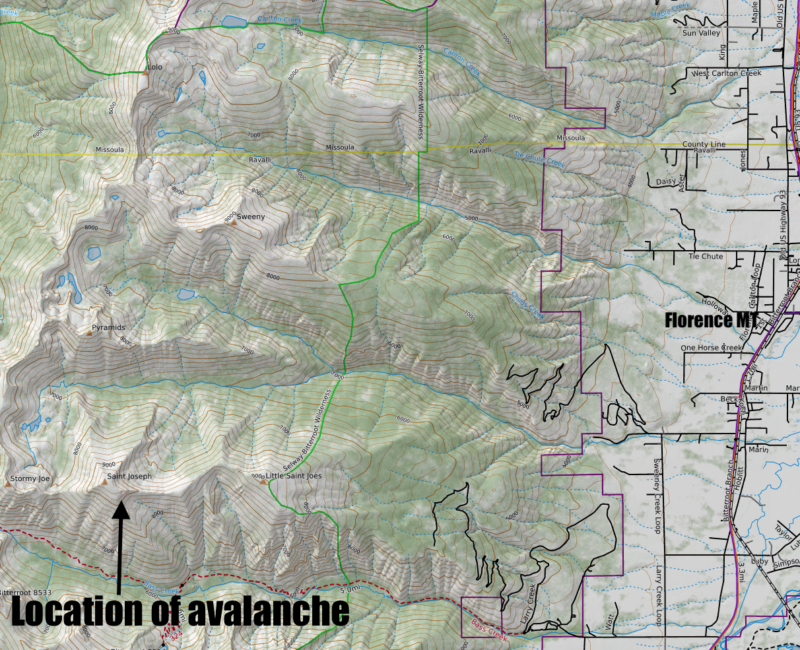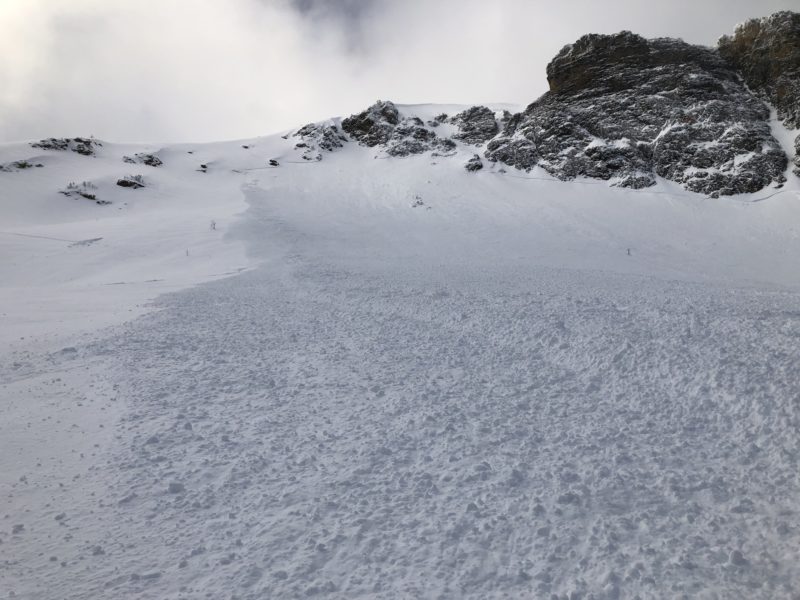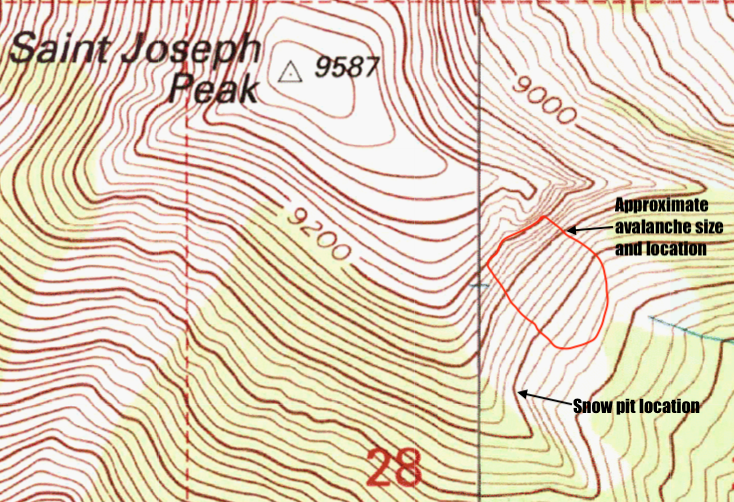On January 3rd of 2021, two experienced skiers triggered an avalanche on the east face of St. Joseph Peak. One skier was caught and carried 300’. Luckily, he skied off the debris and was uninjured. Like all such incidents, there are valuable lessons to be learned through examination. Much can be traced back to the human factor, the process of gathering information, making decisions, and our motivations in avalanche terrain. I’ll examine these over the course of three articles that will be posted weekly.

The overview of the incident was largely taken from the report that the involved skier submitted to the public observations page. It can be viewed here.
Both skiers are experienced with many years of backcountry travel under their belts. The skier who was caught had taken a Recreational Avalanche Level 1 in 2010.
January 3rd started with light drizzle, shifting to wet and then dry snow as the two skiers climbed in elevation. As the day progressed, the weather cleared and the sun emerged. Winds were strong at upper elevations and gusting occasionally from all directions, settling down considerably after 1pm.
The avalanche forecast for January 2nd rated the hazard as moderate and identified wind slab and persistent weak layers as the avalanche problems. It gave the advice to avoid wind-loaded start zones greater than 35º. During the previous two days, the area had received around 5” of new snow. Westerly winds had been moderate and reached 55mph at ridge top.
Their ski objective that day was the mellow SE ramp of Big Jo, which, when approached carefully, can be skied safely in heightened avalanche conditions. Skier 1 (who was most familiar with the area) had no intention of skiing the steeper slope that day. However, a combination of the snow analysis and confidence due to the like-minded camaraderie shared with their ski partner led to a dynamic decision at 9,400′ to ski the steeper slope below, instead of the safe ridge.
The two skiers assessed conditions on their ascent digging pits at 6600’ SE facing, which yielded no results. They also dug at 8800’ on a 32º slope and found 220cm (87”) of snow. This pit yielded an ECTP 22, down 4” which they judged to be Q2. Prompted by the Q2 rating, they performed a propagation saw test and it scored as PSTend 80/100, and judged the likelihood of propagation to be low.
Based on these results, only 4″ of fresh snow at their pit, and a runout zone free of terrain traps such as rocks or cliffs, they decided to ski the slope one at a time.
The run starts at 9,400’ near the top of Big Jo, skirting rocks down into a weakness that leads to a small gully. The gully then empties into the heart of the East Bowl, which averages 35-45 degrees in steepness. The upper bit and the gully were scoured free of new snow, but not the bowl. Skier 1 skied down the slope and stopped to the skier’s right side of the bowl bottom in a safe zone. Skier 2 was spooning Skier 1’s tracks when the slope failed. Skier 2 was mid-turn (facing straight downslope) when they got knocked on their bum and rode on the surface in that position, as the slide slowed down, and stopped. They were able to ski out and off the debris. Skier 1 was a couple of hundred feet skiers right of the terminus of the debris.

The slide occurred at 3:33 pm. The starting zone was between 35-40 degrees, the crown was 300-400’ wide, ranging in depth from 4″-12″, and it slid for about 300′ on the new snow interface of the 12/30-31 storm from about 9,000-8,700’. [SS-AS-R3-D2-S]

The Victim’s Analysis:
“In hindsight, we were following standard protocol but made a bold decision. Each skier was carrying all of the rescue gear, digging to analyze the snow when facing avalanche terrain, skiing one at a time, and communicating about route choice, snow condition, and safe zones. I think we overlooked the ECTP22 score because it was only 4″ down, and a PST of 80/100 assisted our decision to continue up. But Big Jo’s East Bowl is huge and with the wind blowing from everywhere with this storm, it is certain that more snow was deposited on other areas of the bowl. We also didn’t observe any cracking, collapsing, or naturals all day, which no doubt contributed to our thought process. Skier 2 had skied this same line on New Years Day (tracks visible in photo) which likely played into the heuristic trap we got ourselves into, but also helped us confirm the weak layer.”
Further analysis can offer more insight.
Human Factors
Ian McCammon studied avalanche accidents and identified common decision-making errors that people make when assessing hazards in avalanche terrain. He identified 6 heuristic traps that make up the acronym FACETS:
- Familiarity
- If we are familiar with something we feel safer. If it has worked in the past it reinforces our belief that it is safe.
- Acceptance
- The willingness to take more risks in a group setting, because of the desire to fit in.
- Commitment
- If we’ve invested time and effort to get to an objective it’s hard to back off and acknowledge hazards.
- Expert halo
- When we are with someone who has more expertise, or we perceive to have more expertise, we are more willing to follow their lead, and overlook hazards.
- Tracks or scarcity
- The perception that a resource is limited, in this case, powder, can cloud our judgment in the race for first tracks.
- Social proof
- The presence of others or tracks on a slope can lead us to a false sense of security.
You can read more about FACETS here.
Heuristics are mental shortcuts that we all use to make decisions efficiently, and they can be immensely helpful. If we needed to think through all the steps of all the decisions we make each day during routine tasks we would be entirely occupied with making decisions. Driving a car is a good example of how heuristics are used. When we are learning to drive it is an almost overwhelming task to take in and process all the information, but as we learn the skill we create mental shortcuts that facilitate driving efficiently. Similar heuristics are used throughout our daily lives and aid decisions in social as well as skill-based settings. A problem can be created when we apply those mental shortcuts, or employ social heuristics, to making decisions in high-risk situations. This is when they can become traps.
Acceptance, expert halo, social proof, consistency, and to some extent tracks or scarcity are all social or interpersonal heuristics and are mental shortcuts based on how we perceive others and how we would like to be perceived. We are highly social creatures, and as a result, interpersonal heuristics are very ingrained and influential. Research shows that people are much more willing to take risks when a camera is present or with the potential for Instagram-type fame or social standing. The problem is that these heuristics may default to social standing or relationships as a basis for decision shortcuts as opposed to the objective factors of terrain, snowpack, and weather.
Familiarity is the heuristic trap that Skier 2 identified as influencing this incident. McCammon says, “The familiarity heuristic relies on our past actions to guide our behavior in familiar settings. Rather than go through the trouble of figuring out what is appropriate every time, we simply behave as we have before in that setting”. Having skied the same line three days prior, without mishap, contributed to the decision to ski the line again. Furthermore, the two skiers were familiar with the line from numerous previous tours in the area.
Social proof may have also played a role in the decision to ski the line as Skier 2 reflected “…confidence due to the like-minded camaraderie shared with their ski partner led to a dynamic decision at 9,400′ to ski the steeper slope below, instead of the safe ridge”. The description for the social facilitation heuristic states “when a person or group is confident in their skills, they will tend to take more risks using those skills when other people are present than they would when others are absent”.
If heuristics can cause us to make unsafe decisions in avalanche terrain, how do we override them?
While heuristics are mental shortcuts to decision-making, analytical problem solving is the long route, logically thinking out and puzzling over the pieces of a problem. Research suggests that prompts for logical problem solving and consciously engaging in analytic analysis can override heuristics, and help us identify discrepancies between the two decision-making modes or errors in our initial judgment.
Interestingly, McCammon found that people with higher levels of avalanche training were more susceptible to the heuristic traps he identified. Perhaps, in part, because familiarity and comfort with the process results in less analytic analysis, allowing the heuristic process to be more in the forefront.
Adding the extra step of revisiting the decision-making process, including an analysis of human factors before committing to avalanche terrain is a good ritual. This may be the prompt that engages analysis and overrides heuristics. An examination of the social factors that may be affecting the decision to ski a line may also help identify incongruencies between initial decisions and conditions. In the case of this incident, an examination of human factors may have been preventative.
This will undoubtedly help catch some errors. However, an aspect that helps override heuristics is deductive competence. This is a person’s ability to draw the correct conclusions from the evidence. In avalanche terrain, this is directly tied to our competence with snowpack observations and assessment. If our competence with this process is lacking, or we are overloaded by the amount of information, our ability to override heuristics can be compromised.
Assessment of avalanche conditions is analytical problem solving that can take place at many levels of complexity, from simple rule-based decision-making models such as APLTRUTh or the Red Flags to complex observations such as stability tests and crystal identification. Any of these approaches are valid. Developing these competencies, as well as an awareness of FACETS, is essential for safe travel in avalanche terrain.
In the next article, I’ll examine how the observations made contributed to this incident and how those could be corrected.
Stay tuned next week…
Jeff Carty













